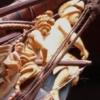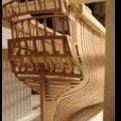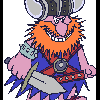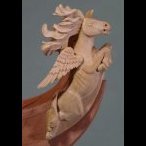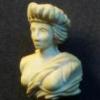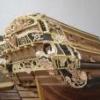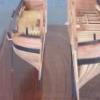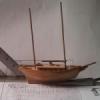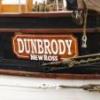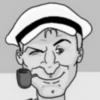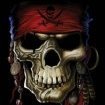MORE HANDBOOKS ARE ON THEIR WAY! We will let you know when they get here.
×
-
Posts
1,307 -
Joined
-
Last visited
Reputation Activity
-
 Gaetan Bordeleau got a reaction from avsjerome2003 in Le Fleuron by Gaetan Bordeleau - FINISHED - 1:24
Gaetan Bordeleau got a reaction from avsjerome2003 in Le Fleuron by Gaetan Bordeleau - FINISHED - 1:24
I began the second dolphin. I received the last link to be able to process photo control from camera to printer.To take a picture with an DSLR camera, you need to control 2 things : light and color.
How much light is entering in the camera is the white balance, a feature of the camera itself. To control the color, a photo of a calibrated Color Checker passport is taken which is a color chart.
The monitor is calibrated taking into account the ambient light. On the picture the monitor can adjust at a lower height than what his original base would allow. Even if Apple do not want anymore that we remove the base, I did not like the height, so I cut the base and replaced with a better one.
The program Adobe Lightroom, corrects the picture and apply printing adjustments.
The printer, the last component of the chain, also needs calibration. The paper also have a specific profile depending his features. Color Munki Photo is a spectrophotometer use for the calibration of the monitor and the printer. It also can be use as a light meter to measure ambient light in Lux.
To verify the calibration, a print is compared with the monitor and they should look like similar.
-
 Gaetan Bordeleau got a reaction from rtropp in Le Fleuron by Gaetan Bordeleau - FINISHED - 1:24
Gaetan Bordeleau got a reaction from rtropp in Le Fleuron by Gaetan Bordeleau - FINISHED - 1:24
I began the second dolphin. I received the last link to be able to process photo control from camera to printer.To take a picture with an DSLR camera, you need to control 2 things : light and color.
How much light is entering in the camera is the white balance, a feature of the camera itself. To control the color, a photo of a calibrated Color Checker passport is taken which is a color chart.
The monitor is calibrated taking into account the ambient light. On the picture the monitor can adjust at a lower height than what his original base would allow. Even if Apple do not want anymore that we remove the base, I did not like the height, so I cut the base and replaced with a better one.
The program Adobe Lightroom, corrects the picture and apply printing adjustments.
The printer, the last component of the chain, also needs calibration. The paper also have a specific profile depending his features. Color Munki Photo is a spectrophotometer use for the calibration of the monitor and the printer. It also can be use as a light meter to measure ambient light in Lux.
To verify the calibration, a print is compared with the monitor and they should look like similar.
-
 Gaetan Bordeleau got a reaction from michael mott in Le Fleuron by Gaetan Bordeleau - FINISHED - 1:24
Gaetan Bordeleau got a reaction from michael mott in Le Fleuron by Gaetan Bordeleau - FINISHED - 1:24
I began the second dolphin. I received the last link to be able to process photo control from camera to printer.To take a picture with an DSLR camera, you need to control 2 things : light and color.
How much light is entering in the camera is the white balance, a feature of the camera itself. To control the color, a photo of a calibrated Color Checker passport is taken which is a color chart.
The monitor is calibrated taking into account the ambient light. On the picture the monitor can adjust at a lower height than what his original base would allow. Even if Apple do not want anymore that we remove the base, I did not like the height, so I cut the base and replaced with a better one.
The program Adobe Lightroom, corrects the picture and apply printing adjustments.
The printer, the last component of the chain, also needs calibration. The paper also have a specific profile depending his features. Color Munki Photo is a spectrophotometer use for the calibration of the monitor and the printer. It also can be use as a light meter to measure ambient light in Lux.
To verify the calibration, a print is compared with the monitor and they should look like similar.
-
 Gaetan Bordeleau got a reaction from ChrisLBren in Le Fleuron by Gaetan Bordeleau - FINISHED - 1:24
Gaetan Bordeleau got a reaction from ChrisLBren in Le Fleuron by Gaetan Bordeleau - FINISHED - 1:24
I began the second dolphin. I received the last link to be able to process photo control from camera to printer.To take a picture with an DSLR camera, you need to control 2 things : light and color.
How much light is entering in the camera is the white balance, a feature of the camera itself. To control the color, a photo of a calibrated Color Checker passport is taken which is a color chart.
The monitor is calibrated taking into account the ambient light. On the picture the monitor can adjust at a lower height than what his original base would allow. Even if Apple do not want anymore that we remove the base, I did not like the height, so I cut the base and replaced with a better one.
The program Adobe Lightroom, corrects the picture and apply printing adjustments.
The printer, the last component of the chain, also needs calibration. The paper also have a specific profile depending his features. Color Munki Photo is a spectrophotometer use for the calibration of the monitor and the printer. It also can be use as a light meter to measure ambient light in Lux.
To verify the calibration, a print is compared with the monitor and they should look like similar.
-
 Gaetan Bordeleau got a reaction from Jeronimo in Le Fleuron by Gaetan Bordeleau - FINISHED - 1:24
Gaetan Bordeleau got a reaction from Jeronimo in Le Fleuron by Gaetan Bordeleau - FINISHED - 1:24
I began the second dolphin. I received the last link to be able to process photo control from camera to printer.To take a picture with an DSLR camera, you need to control 2 things : light and color.
How much light is entering in the camera is the white balance, a feature of the camera itself. To control the color, a photo of a calibrated Color Checker passport is taken which is a color chart.
The monitor is calibrated taking into account the ambient light. On the picture the monitor can adjust at a lower height than what his original base would allow. Even if Apple do not want anymore that we remove the base, I did not like the height, so I cut the base and replaced with a better one.
The program Adobe Lightroom, corrects the picture and apply printing adjustments.
The printer, the last component of the chain, also needs calibration. The paper also have a specific profile depending his features. Color Munki Photo is a spectrophotometer use for the calibration of the monitor and the printer. It also can be use as a light meter to measure ambient light in Lux.
To verify the calibration, a print is compared with the monitor and they should look like similar.
-
 Gaetan Bordeleau got a reaction from qwerty2008 in Le Fleuron by Gaetan Bordeleau - FINISHED - 1:24
Gaetan Bordeleau got a reaction from qwerty2008 in Le Fleuron by Gaetan Bordeleau - FINISHED - 1:24
I began the second dolphin. I received the last link to be able to process photo control from camera to printer.To take a picture with an DSLR camera, you need to control 2 things : light and color.
How much light is entering in the camera is the white balance, a feature of the camera itself. To control the color, a photo of a calibrated Color Checker passport is taken which is a color chart.
The monitor is calibrated taking into account the ambient light. On the picture the monitor can adjust at a lower height than what his original base would allow. Even if Apple do not want anymore that we remove the base, I did not like the height, so I cut the base and replaced with a better one.
The program Adobe Lightroom, corrects the picture and apply printing adjustments.
The printer, the last component of the chain, also needs calibration. The paper also have a specific profile depending his features. Color Munki Photo is a spectrophotometer use for the calibration of the monitor and the printer. It also can be use as a light meter to measure ambient light in Lux.
To verify the calibration, a print is compared with the monitor and they should look like similar.
-
 Gaetan Bordeleau got a reaction from WackoWolf in Le Fleuron by Gaetan Bordeleau - FINISHED - 1:24
Gaetan Bordeleau got a reaction from WackoWolf in Le Fleuron by Gaetan Bordeleau - FINISHED - 1:24
I began the second dolphin. I received the last link to be able to process photo control from camera to printer.To take a picture with an DSLR camera, you need to control 2 things : light and color.
How much light is entering in the camera is the white balance, a feature of the camera itself. To control the color, a photo of a calibrated Color Checker passport is taken which is a color chart.
The monitor is calibrated taking into account the ambient light. On the picture the monitor can adjust at a lower height than what his original base would allow. Even if Apple do not want anymore that we remove the base, I did not like the height, so I cut the base and replaced with a better one.
The program Adobe Lightroom, corrects the picture and apply printing adjustments.
The printer, the last component of the chain, also needs calibration. The paper also have a specific profile depending his features. Color Munki Photo is a spectrophotometer use for the calibration of the monitor and the printer. It also can be use as a light meter to measure ambient light in Lux.
To verify the calibration, a print is compared with the monitor and they should look like similar.
-
 Gaetan Bordeleau got a reaction from Trussben in Le Fleuron by Gaetan Bordeleau - FINISHED - 1:24
Gaetan Bordeleau got a reaction from Trussben in Le Fleuron by Gaetan Bordeleau - FINISHED - 1:24
Hi Mauricio,
In comparison with the previous model, the 74 built at the same scale, 70% wasmade with cherry.
I even paid $50 US a judge in a competition to tell me this: ''The biggest issue with this model was the choice of wood used. In many cases, the grain appeared out of scale.''
I must have some comprehension problems, 100% of the actual wood for this build is cherry.
Even sculptures are made with cherry. According traditions, sculptures were made with boxwood. How could we know if different woods can be use if nobody try it?
I also experienced cherry for sculptures in the 74 also and I was please with the results.
I was very satisfy with the resulting colors on the 74.
For Le Fleuron, I wanted to try a different wood combination and I understand that when at least 3 peoples look at the model, there is a good chance that at least one will not like it.
-
 Gaetan Bordeleau got a reaction from avsjerome2003 in Le Fleuron by Gaetan Bordeleau - FINISHED - 1:24
Gaetan Bordeleau got a reaction from avsjerome2003 in Le Fleuron by Gaetan Bordeleau - FINISHED - 1:24
Hi Druxey, you are so right about preconception. I also saw it in an article about exacto versus chirurgical blade #11. To my great surprise exacto blades seems more popular than #11 blade. But I guess that this misconception will change when they will try #11 after few days.
To come back to cherry which is easily available for me. I do not use holly as you simply because it is not available in Quebec, but I bought some planks many years ago.
I will show other cherry sculptures, but before I will pass by Paris to show you some dolphins. To be able to begin the dolphins (photo 1), some additionnal drawings are required. The first reference I found is (photo 2) This picture could be coming from Paris but I do not know. I prefer another one : Fontana del tritone 1642 (photo 3) by one of the best sculptor; Gian Lorenzo Bernini. In the same order Antonio Canova did Cupid and Psyche (photo 4). For those wondering if cherry can take details, I did in 1999 a copy of this work (photo 5). To finalize the drawings, I did combine a picture of another french for the body and the face of Bernini dolphins (photo 6). Finally, to have an idea why there are so much ornementation in this period, look a table from the Baroque period (photo 7).
-
 Gaetan Bordeleau got a reaction from archjofo in Le Fleuron by Gaetan Bordeleau - FINISHED - 1:24
Gaetan Bordeleau got a reaction from archjofo in Le Fleuron by Gaetan Bordeleau - FINISHED - 1:24
Hi Druxey, you are so right about preconception. I also saw it in an article about exacto versus chirurgical blade #11. To my great surprise exacto blades seems more popular than #11 blade. But I guess that this misconception will change when they will try #11 after few days.
To come back to cherry which is easily available for me. I do not use holly as you simply because it is not available in Quebec, but I bought some planks many years ago.
I will show other cherry sculptures, but before I will pass by Paris to show you some dolphins. To be able to begin the dolphins (photo 1), some additionnal drawings are required. The first reference I found is (photo 2) This picture could be coming from Paris but I do not know. I prefer another one : Fontana del tritone 1642 (photo 3) by one of the best sculptor; Gian Lorenzo Bernini. In the same order Antonio Canova did Cupid and Psyche (photo 4). For those wondering if cherry can take details, I did in 1999 a copy of this work (photo 5). To finalize the drawings, I did combine a picture of another french for the body and the face of Bernini dolphins (photo 6). Finally, to have an idea why there are so much ornementation in this period, look a table from the Baroque period (photo 7).
-
 Gaetan Bordeleau got a reaction from paulsutcliffe in Le Fleuron by Gaetan Bordeleau - FINISHED - 1:24
Gaetan Bordeleau got a reaction from paulsutcliffe in Le Fleuron by Gaetan Bordeleau - FINISHED - 1:24
COMPLETING 2D PARTS
Progression continues, 2D portion is now completed. I tried to do it in 1 block. This way it is easier to have the same style in the carvings. To give a bigger volume to the 2D parts, many were cut in a thicker plank than require (especially the flowers) in a way, trying to make it look bit more 3D than it is really.
Some parts were directly made from the plans, other were made according the place on the exact place where i twill be install on the model. This way the parts fits before to be carved.
Remaining sculptures are 3D noted in red on the original drawings. On the first picture.
On the second picture, 4 pictures regrouped to give an idea of the progression of the construction; which is similar in many ways to a house : framing, walls, moldings and decoration on the other pics.
The third pic is to show how to work standing having every thing at the good height.
-
 Gaetan Bordeleau got a reaction from captgino in Le Fleuron by Gaetan Bordeleau - FINISHED - 1:24
Gaetan Bordeleau got a reaction from captgino in Le Fleuron by Gaetan Bordeleau - FINISHED - 1:24
COMPLETING 2D PARTS
Progression continues, 2D portion is now completed. I tried to do it in 1 block. This way it is easier to have the same style in the carvings. To give a bigger volume to the 2D parts, many were cut in a thicker plank than require (especially the flowers) in a way, trying to make it look bit more 3D than it is really.
Some parts were directly made from the plans, other were made according the place on the exact place where i twill be install on the model. This way the parts fits before to be carved.
Remaining sculptures are 3D noted in red on the original drawings. On the first picture.
On the second picture, 4 pictures regrouped to give an idea of the progression of the construction; which is similar in many ways to a house : framing, walls, moldings and decoration on the other pics.
The third pic is to show how to work standing having every thing at the good height.
-
 Gaetan Bordeleau got a reaction from Trussben in Le Fleuron by Gaetan Bordeleau - FINISHED - 1:24
Gaetan Bordeleau got a reaction from Trussben in Le Fleuron by Gaetan Bordeleau - FINISHED - 1:24
Hi Druxey, you are so right about preconception. I also saw it in an article about exacto versus chirurgical blade #11. To my great surprise exacto blades seems more popular than #11 blade. But I guess that this misconception will change when they will try #11 after few days.
To come back to cherry which is easily available for me. I do not use holly as you simply because it is not available in Quebec, but I bought some planks many years ago.
I will show other cherry sculptures, but before I will pass by Paris to show you some dolphins. To be able to begin the dolphins (photo 1), some additionnal drawings are required. The first reference I found is (photo 2) This picture could be coming from Paris but I do not know. I prefer another one : Fontana del tritone 1642 (photo 3) by one of the best sculptor; Gian Lorenzo Bernini. In the same order Antonio Canova did Cupid and Psyche (photo 4). For those wondering if cherry can take details, I did in 1999 a copy of this work (photo 5). To finalize the drawings, I did combine a picture of another french for the body and the face of Bernini dolphins (photo 6). Finally, to have an idea why there are so much ornementation in this period, look a table from the Baroque period (photo 7).
-
 Gaetan Bordeleau got a reaction from avsjerome2003 in Le Fleuron by Gaetan Bordeleau - FINISHED - 1:24
Gaetan Bordeleau got a reaction from avsjerome2003 in Le Fleuron by Gaetan Bordeleau - FINISHED - 1:24
COMPLETING 2D PARTS
Progression continues, 2D portion is now completed. I tried to do it in 1 block. This way it is easier to have the same style in the carvings. To give a bigger volume to the 2D parts, many were cut in a thicker plank than require (especially the flowers) in a way, trying to make it look bit more 3D than it is really.
Some parts were directly made from the plans, other were made according the place on the exact place where i twill be install on the model. This way the parts fits before to be carved.
Remaining sculptures are 3D noted in red on the original drawings. On the first picture.
On the second picture, 4 pictures regrouped to give an idea of the progression of the construction; which is similar in many ways to a house : framing, walls, moldings and decoration on the other pics.
The third pic is to show how to work standing having every thing at the good height.
-
 Gaetan Bordeleau got a reaction from cabrapente in Le Fleuron by Gaetan Bordeleau - FINISHED - 1:24
Gaetan Bordeleau got a reaction from cabrapente in Le Fleuron by Gaetan Bordeleau - FINISHED - 1:24
Hi Druxey, you are so right about preconception. I also saw it in an article about exacto versus chirurgical blade #11. To my great surprise exacto blades seems more popular than #11 blade. But I guess that this misconception will change when they will try #11 after few days.
To come back to cherry which is easily available for me. I do not use holly as you simply because it is not available in Quebec, but I bought some planks many years ago.
I will show other cherry sculptures, but before I will pass by Paris to show you some dolphins. To be able to begin the dolphins (photo 1), some additionnal drawings are required. The first reference I found is (photo 2) This picture could be coming from Paris but I do not know. I prefer another one : Fontana del tritone 1642 (photo 3) by one of the best sculptor; Gian Lorenzo Bernini. In the same order Antonio Canova did Cupid and Psyche (photo 4). For those wondering if cherry can take details, I did in 1999 a copy of this work (photo 5). To finalize the drawings, I did combine a picture of another french for the body and the face of Bernini dolphins (photo 6). Finally, to have an idea why there are so much ornementation in this period, look a table from the Baroque period (photo 7).
-
 Gaetan Bordeleau got a reaction from dgbot in Le Fleuron by Gaetan Bordeleau - FINISHED - 1:24
Gaetan Bordeleau got a reaction from dgbot in Le Fleuron by Gaetan Bordeleau - FINISHED - 1:24
Hi Druxey, you are so right about preconception. I also saw it in an article about exacto versus chirurgical blade #11. To my great surprise exacto blades seems more popular than #11 blade. But I guess that this misconception will change when they will try #11 after few days.
To come back to cherry which is easily available for me. I do not use holly as you simply because it is not available in Quebec, but I bought some planks many years ago.
I will show other cherry sculptures, but before I will pass by Paris to show you some dolphins. To be able to begin the dolphins (photo 1), some additionnal drawings are required. The first reference I found is (photo 2) This picture could be coming from Paris but I do not know. I prefer another one : Fontana del tritone 1642 (photo 3) by one of the best sculptor; Gian Lorenzo Bernini. In the same order Antonio Canova did Cupid and Psyche (photo 4). For those wondering if cherry can take details, I did in 1999 a copy of this work (photo 5). To finalize the drawings, I did combine a picture of another french for the body and the face of Bernini dolphins (photo 6). Finally, to have an idea why there are so much ornementation in this period, look a table from the Baroque period (photo 7).
-
 Gaetan Bordeleau got a reaction from tlevine in Le Fleuron by Gaetan Bordeleau - FINISHED - 1:24
Gaetan Bordeleau got a reaction from tlevine in Le Fleuron by Gaetan Bordeleau - FINISHED - 1:24
COMPLETING 2D PARTS
Progression continues, 2D portion is now completed. I tried to do it in 1 block. This way it is easier to have the same style in the carvings. To give a bigger volume to the 2D parts, many were cut in a thicker plank than require (especially the flowers) in a way, trying to make it look bit more 3D than it is really.
Some parts were directly made from the plans, other were made according the place on the exact place where i twill be install on the model. This way the parts fits before to be carved.
Remaining sculptures are 3D noted in red on the original drawings. On the first picture.
On the second picture, 4 pictures regrouped to give an idea of the progression of the construction; which is similar in many ways to a house : framing, walls, moldings and decoration on the other pics.
The third pic is to show how to work standing having every thing at the good height.
-
 Gaetan Bordeleau got a reaction from cog in Le Fleuron by Gaetan Bordeleau - FINISHED - 1:24
Gaetan Bordeleau got a reaction from cog in Le Fleuron by Gaetan Bordeleau - FINISHED - 1:24
Hi Druxey, you are so right about preconception. I also saw it in an article about exacto versus chirurgical blade #11. To my great surprise exacto blades seems more popular than #11 blade. But I guess that this misconception will change when they will try #11 after few days.
To come back to cherry which is easily available for me. I do not use holly as you simply because it is not available in Quebec, but I bought some planks many years ago.
I will show other cherry sculptures, but before I will pass by Paris to show you some dolphins. To be able to begin the dolphins (photo 1), some additionnal drawings are required. The first reference I found is (photo 2) This picture could be coming from Paris but I do not know. I prefer another one : Fontana del tritone 1642 (photo 3) by one of the best sculptor; Gian Lorenzo Bernini. In the same order Antonio Canova did Cupid and Psyche (photo 4). For those wondering if cherry can take details, I did in 1999 a copy of this work (photo 5). To finalize the drawings, I did combine a picture of another french for the body and the face of Bernini dolphins (photo 6). Finally, to have an idea why there are so much ornementation in this period, look a table from the Baroque period (photo 7).
-
 Gaetan Bordeleau got a reaction from michael mott in Le Fleuron by Gaetan Bordeleau - FINISHED - 1:24
Gaetan Bordeleau got a reaction from michael mott in Le Fleuron by Gaetan Bordeleau - FINISHED - 1:24
Hi Druxey, you are so right about preconception. I also saw it in an article about exacto versus chirurgical blade #11. To my great surprise exacto blades seems more popular than #11 blade. But I guess that this misconception will change when they will try #11 after few days.
To come back to cherry which is easily available for me. I do not use holly as you simply because it is not available in Quebec, but I bought some planks many years ago.
I will show other cherry sculptures, but before I will pass by Paris to show you some dolphins. To be able to begin the dolphins (photo 1), some additionnal drawings are required. The first reference I found is (photo 2) This picture could be coming from Paris but I do not know. I prefer another one : Fontana del tritone 1642 (photo 3) by one of the best sculptor; Gian Lorenzo Bernini. In the same order Antonio Canova did Cupid and Psyche (photo 4). For those wondering if cherry can take details, I did in 1999 a copy of this work (photo 5). To finalize the drawings, I did combine a picture of another french for the body and the face of Bernini dolphins (photo 6). Finally, to have an idea why there are so much ornementation in this period, look a table from the Baroque period (photo 7).
-
 Gaetan Bordeleau got a reaction from Krelis in Le Fleuron by Gaetan Bordeleau - FINISHED - 1:24
Gaetan Bordeleau got a reaction from Krelis in Le Fleuron by Gaetan Bordeleau - FINISHED - 1:24
COMPLETING 2D PARTS
Progression continues, 2D portion is now completed. I tried to do it in 1 block. This way it is easier to have the same style in the carvings. To give a bigger volume to the 2D parts, many were cut in a thicker plank than require (especially the flowers) in a way, trying to make it look bit more 3D than it is really.
Some parts were directly made from the plans, other were made according the place on the exact place where i twill be install on the model. This way the parts fits before to be carved.
Remaining sculptures are 3D noted in red on the original drawings. On the first picture.
On the second picture, 4 pictures regrouped to give an idea of the progression of the construction; which is similar in many ways to a house : framing, walls, moldings and decoration on the other pics.
The third pic is to show how to work standing having every thing at the good height.
-
 Gaetan Bordeleau got a reaction from Mahuna in Le Fleuron by Gaetan Bordeleau - FINISHED - 1:24
Gaetan Bordeleau got a reaction from Mahuna in Le Fleuron by Gaetan Bordeleau - FINISHED - 1:24
Hi Druxey, you are so right about preconception. I also saw it in an article about exacto versus chirurgical blade #11. To my great surprise exacto blades seems more popular than #11 blade. But I guess that this misconception will change when they will try #11 after few days.
To come back to cherry which is easily available for me. I do not use holly as you simply because it is not available in Quebec, but I bought some planks many years ago.
I will show other cherry sculptures, but before I will pass by Paris to show you some dolphins. To be able to begin the dolphins (photo 1), some additionnal drawings are required. The first reference I found is (photo 2) This picture could be coming from Paris but I do not know. I prefer another one : Fontana del tritone 1642 (photo 3) by one of the best sculptor; Gian Lorenzo Bernini. In the same order Antonio Canova did Cupid and Psyche (photo 4). For those wondering if cherry can take details, I did in 1999 a copy of this work (photo 5). To finalize the drawings, I did combine a picture of another french for the body and the face of Bernini dolphins (photo 6). Finally, to have an idea why there are so much ornementation in this period, look a table from the Baroque period (photo 7).
-
 Gaetan Bordeleau got a reaction from Jaekon Lee in Le Fleuron by Gaetan Bordeleau - FINISHED - 1:24
Gaetan Bordeleau got a reaction from Jaekon Lee in Le Fleuron by Gaetan Bordeleau - FINISHED - 1:24
Hi Druxey, you are so right about preconception. I also saw it in an article about exacto versus chirurgical blade #11. To my great surprise exacto blades seems more popular than #11 blade. But I guess that this misconception will change when they will try #11 after few days.
To come back to cherry which is easily available for me. I do not use holly as you simply because it is not available in Quebec, but I bought some planks many years ago.
I will show other cherry sculptures, but before I will pass by Paris to show you some dolphins. To be able to begin the dolphins (photo 1), some additionnal drawings are required. The first reference I found is (photo 2) This picture could be coming from Paris but I do not know. I prefer another one : Fontana del tritone 1642 (photo 3) by one of the best sculptor; Gian Lorenzo Bernini. In the same order Antonio Canova did Cupid and Psyche (photo 4). For those wondering if cherry can take details, I did in 1999 a copy of this work (photo 5). To finalize the drawings, I did combine a picture of another french for the body and the face of Bernini dolphins (photo 6). Finally, to have an idea why there are so much ornementation in this period, look a table from the Baroque period (photo 7).
-
 Gaetan Bordeleau got a reaction from mtaylor in Le Fleuron by Gaetan Bordeleau - FINISHED - 1:24
Gaetan Bordeleau got a reaction from mtaylor in Le Fleuron by Gaetan Bordeleau - FINISHED - 1:24
Hi Druxey, you are so right about preconception. I also saw it in an article about exacto versus chirurgical blade #11. To my great surprise exacto blades seems more popular than #11 blade. But I guess that this misconception will change when they will try #11 after few days.
To come back to cherry which is easily available for me. I do not use holly as you simply because it is not available in Quebec, but I bought some planks many years ago.
I will show other cherry sculptures, but before I will pass by Paris to show you some dolphins. To be able to begin the dolphins (photo 1), some additionnal drawings are required. The first reference I found is (photo 2) This picture could be coming from Paris but I do not know. I prefer another one : Fontana del tritone 1642 (photo 3) by one of the best sculptor; Gian Lorenzo Bernini. In the same order Antonio Canova did Cupid and Psyche (photo 4). For those wondering if cherry can take details, I did in 1999 a copy of this work (photo 5). To finalize the drawings, I did combine a picture of another french for the body and the face of Bernini dolphins (photo 6). Finally, to have an idea why there are so much ornementation in this period, look a table from the Baroque period (photo 7).
-
 Gaetan Bordeleau got a reaction from archjofo in Le Fleuron by Gaetan Bordeleau - FINISHED - 1:24
Gaetan Bordeleau got a reaction from archjofo in Le Fleuron by Gaetan Bordeleau - FINISHED - 1:24
COMPLETING 2D PARTS
Progression continues, 2D portion is now completed. I tried to do it in 1 block. This way it is easier to have the same style in the carvings. To give a bigger volume to the 2D parts, many were cut in a thicker plank than require (especially the flowers) in a way, trying to make it look bit more 3D than it is really.
Some parts were directly made from the plans, other were made according the place on the exact place where i twill be install on the model. This way the parts fits before to be carved.
Remaining sculptures are 3D noted in red on the original drawings. On the first picture.
On the second picture, 4 pictures regrouped to give an idea of the progression of the construction; which is similar in many ways to a house : framing, walls, moldings and decoration on the other pics.
The third pic is to show how to work standing having every thing at the good height.
-
 Gaetan Bordeleau got a reaction from Captain Poison in Le Fleuron by Gaetan Bordeleau - FINISHED - 1:24
Gaetan Bordeleau got a reaction from Captain Poison in Le Fleuron by Gaetan Bordeleau - FINISHED - 1:24
I have a copy of what appeared on MSW. I do
not think that putting it back page by page, image by image is the fastest
solution. If there would be a section where parts of the ex-forum could be
include, I would be more than happy to put a copy.
For the moment, I tried to make a big picture of previous work, but I should try with
another program.
The next update will be for the actual build: Le Fleuron built completely in cherry.


